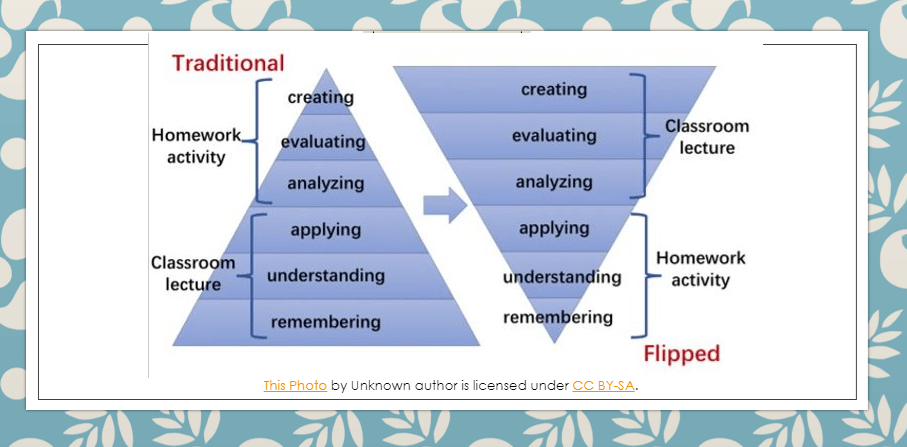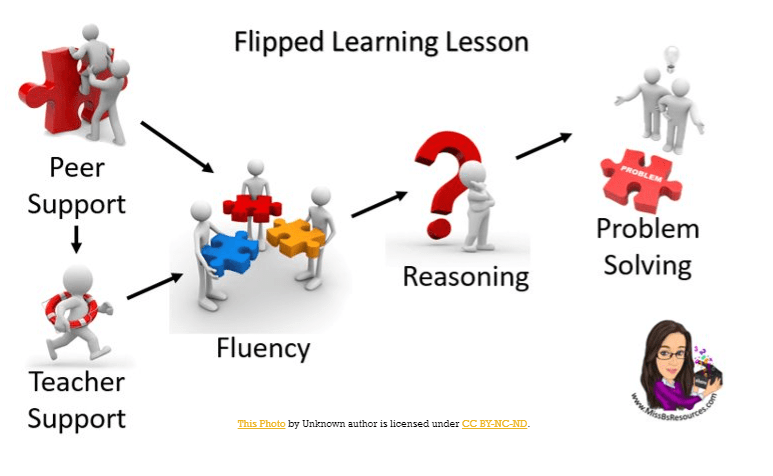Technology has become an integral part of education and many teachers have made the conscious decision to integrate emerging technologies inventively within their professional practice. Basal (2015) believes that technology enriched learning environments increase the learning opportunities for students, as it allows them to improve their ICT acuity, increases their engagement with the content and provides valuable classroom discussion time. One such way of integrating technology in a meaningful manner is the use of flipped learning or flipped classrooms.
By inverting the learning sequence, students gain access to the content prior to the lesson which allows them to address the understanding in the lesson.
This access to content occurs in a personalised, student centred manner through a variety of methods, including the reading course notes, and the accessing videos or other multimedia (Basal, 2015). Flipped classrooms follow a constructivist approach to learning as students are required to take ownership by accessing the content in their own time, at their own pace (Basal, 2015). This self paced approach increases the likelihood of students making those valuable connections between new content and prior knowledge, and therefore improving their overall learning outcomes.
Flipped learning student centred approach can be seen clearly during class time, where the student is able to apply their knowledge and understanding to the learning activities. Additionally, as Leask (2014) points out, student engagement and learning is easier to observe and document when teachers are able to view them applying their knowledge. By addressing content earlier, the teacher is able to assist individual students with cementing their understanding and clarifying misconceptions (Schmidt & Ralph, 2016, p.1). The other advantage is that the students are required to take responsibility for their own learning by accessing the content in their own time and prior to the lesson.

Flipped Classrooms changes the role of the teacher from font of knowledge to facilitator of learning.
There are several benefits to using a flipped classroom in pedagogical practice. One benefit to implementing this strategy is that it reduces or eliminates the ineffective lecturing teaching style (Basal, 2015). The lecture format is a very traditional form of teaching and alludes to the illusion that the teacher is the font of knowledge, and the student the receptacle receiving the information in a passive manner. Flipped classrooms, as Basal (2015) points out, requires the teacher to become a facilitator and organiser of content, rather than a font of content. This role reversal changes the classroom dynamics from a teacher centred to a student centred approach.
The student centred approach is visible throughout the strategy. Leask (2014) points out that student engagement and learning is easier to observe and document when teachers are able to view interactions in class discussions and thereby assess the quality of interactions the student has made with the content prior to the lesson. The early delivery of content also facilitates learning as the teacher is able to assist individual students with cementing their understanding and clarifying misconceptions, which is essential for low ability and low literacy students (Schmidt & Ralph, 2016, p.1). This guided class discussion and application is very provident for students that are unable to receive assistance at home for their learning. Flipped classrooms increase learning outcomes as students are required to take responsibility for their own learning and that students gain confidence in class discussions due to the prior access to content material (Basal, 2015, p.32).
An indirect positive consequence of flipped learning is that the creation of videos for students to access prior to the lesson also provides access to content for students who are unable to attend school due to illness or personal circumstances (Schmidt & Ralph, 2016, p.1). Prior to 2020, remote learning and remote access to content was not a priority but with the recent pandemic and resulting lockdown, flexible and adaptable learning have become a concern for many teachers across the country.
Whilst there are many benefits to using flipped classrooms in pedagogical practice, there are concerns. The primary issue is the creation of resources such as videos and other forms of multimedia to deliver the content. Schmidt & Ralph (2016) point out that even though the making of videos can be extremely time consuming, teachers should not divert to mundane Powerpoints and repetitive videos as they can lead to student boredom and disengagement. Another issue is that students can be disinclined to access the coursework prior to the lesson, and this disinclination can affect the vibrancy of the class learning and discussion (Ozdamli & Asiksoy, 2016). Another major concern with implementing flipped learning in pedagogical practice is access to personal devices and reliable internet outside of school. This makes accessing these resources such as online videos and other multimedia texts difficult for First Nations students, learners from lower socioeconomic families as well as rural and remote areas (DIIS, 2016).
Successful flipped classrooms are more than just the creation and dispersal of didactic videos outside the classroom. Rather it is the collaborative learning and classroom discussion that is provoked by the content material that occurs in the classroom that makes flipped learning successful (Basal, 2015). It is about the students being able to clarify their understanding and address any misconceptions that they may have. Flipped learning requires both the student and teacher to adapt their perspective of teaching and gives teachers additional class time to focus on making meaning of new information in a student centred manner (Basel, 2015). It requires students to be proactive, engage with the content prior to the class, and in discussion during the class. It requires teachers to be willing to experiment with technologies, and relinquish didacticism in favour for constructivism. Flipped classrooms will not meet the needs of all students and their teachers, but it is will work for the majority.
REFERENCES:
Basal, A. (2015). The implementation of a flipped classroom in foreign language teaching. Turkish Online Journal of Distance Education 16 (4). DOI:: 10.17718/tojde.72185
Department of Industry, Innovation and Science. (2016). Australia’s digital economy update. Retrieved from https://apo.org.au/sites/default/files/resource-files/2016/05/apo-nid66202-1210631.pdf
Leask, A. (2014). 5 reasons why the flipped classroom benefits educators. Enable Education – Online learning solutions. Retrieved from https://www.enableeducation.com/5-reasons-why-the-flipped-classroom-benefits-educators/
Lo, C. K. (2017). A critical review of flipped classroom challenges in K-12 education: possible solutions and recommendations for future research. Research and Practice in Technology Enhanced Learning 12 (4). Retrieved from https://www.ncbi.nlm.nih.gov/pmc/articles/PMC6302872/pdf/41039_2016_Article_44.pdf
Ozdamli, F., & Asiksoy, G. (2016). Flipped classroom approach. World Journal on Educational Technology: Current Issues. 8(2), p98-105. Retrieved from https://files.eric.ed.gov/fulltext/EJ1141886.pdf
Schmidt, S. & Ralph, D. (2016). The flipped classroom: a twist on teaching. Contemporary Issues in Education Research. 9(1). Retrieved from https://files.eric.ed.gov/fulltext/EJ1087603.pdf
Szparagowski, R. (2014). The effectiveness of the flipped classroom. Bowling Green State University Scholar Works. Retrieved from https://scholarworks.bgsu.edu/cgi/viewcontent.cgi?article=1118&context=honorsprojects



